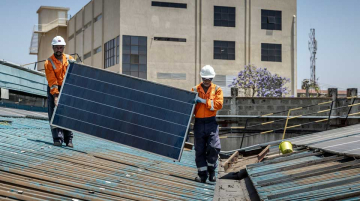
By Diego Morro
In a recent virtual meeting with world leaders on Climate and the Just Transition, Chinese leader Xi Jinping stated that China will not slow its climate efforts or reduce support for international cooperation. This builds on his 2021 pledge to end support for new overseas coal projects and ramp up support for renewable energy. Xi’s 2021 announcement marked an important shift in China’s global energy policy, particularly as developing countries excluding China face estimated financing needs of $1 trillion per year by 2030 to achieve climate and development goals.
How well have Chinese financiers followed through on that commitment?
A new update to the China’s Global Power (CGP) Database shows that, since 2022, Chinese development finance institutions (DFIs), mergers and acquisitions (M&A), and greenfield investors have stopped new funding for coal power plants. Over 68 percent of overseas generation capacity funded in 2022 and 2023 was allocated to solar and wind renewable energy projects. In comparison, nearly 13 percent was directed towards solar and wind between 2000-2021. This shift indicates broad investor alignment with Xi Jinping’s pledge.

The CGP Database, managed by the Boston University Global Development Policy Center, tracks global power plants outside of China financed by foreign direct investment (FDI) and/or lending from China’s DFIs.
Despite this shift, China’s global power portfolio remains relatively carbon intensive. Fossil fuel projects represent 56 percent of cumulative operational capacity of Chinese-funded plants. In 2023, annual emissions from these plants reached 287 million tons (Mt) of carbon dioxide (CO2), which is roughly equivalent to the annual energy-related CO2 emissions from Malaysia or the United Arab Emirates (UAE).
While China has stopped financing for new coal projects, previously planned projects continue to come online. For example, the Hwange Thermal Power Station expansion in Zimbabwe, funded by an Export-Import Bank of China loan in 2016, was commissioned in 2023. Between 2022-2023, 8 GW of coal capacity became operational, with an additional 9 GW either planned or under construction, representing 19 percent of the capacity in the pipeline.

Although renewable energy now dominates new investments, the scale of this shift remains limited. Only 3 GW of renewable capacity was funded between 2022-2023. This funding is heavily concentrated in Asia and the Americas, with Africa receiving just 4 percent. Chinese greenfield investors have largely bypassed the continent, limiting renewable energy expansion where it is most needed.
For Africa, last year’s pledge at the ninth Forum on China-Africa Cooperation (FOCAC) could mark a shift. Xi committed $51 billion to support Africa’s development over the next three years, including the construction of 30 new clean energy projects. While the financing details remain unclear, DFIs could still play a role, particularly through smaller-scale projects that align with the “small is beautiful” approach. These could focus on wind, solar or even small hydropower—such as CHEXIM’s 2023 commitment to fund the 64 MW Ranomafana Hydropower Plant in Madagascar.
This latest CGP Database update reveals three insights that can help to further accelerate decarbonization and boost renewable energy investments.
First, ceasing funding for new coal projects is a crucial first step that has so far been delivered. Redirecting or repurposing planned coal projects towards cleaner energy sources would also have significant environmental benefits, potentially avoiding up to 41 Mt of additional annual CO2 emissions.
Second, the CGP Database highlights the need to prioritize decarbonization efforts in Asia. The region accounts for 71 percent of DFI-backed coal project capacity. Africa follows at 27 percent.
Finally, the data underscores the importance of mobilizing private investments. Greenfield is not only the primary conduit for clean energy financing but also, between 2022-2023, led power generation funding overall. To attract more investments that positively impact economic development, it is essential for host countries and China to identify projects with revenue potential, while adhering to high environmental, social and governance (ESG) standards.
One promising initiative is the Green Investment and Finance Partnership (GIFP), introduced by China in the 2023 Belt and Road Forum. Designed as a platform to support Belt and Road Initiative countries in developing green projects, the GIFP aims to fund feasibility studies, risk analysis and technical support to help build a robust pipeline of renewable energy projects for the future.
Diego Morro is a Data Analyst and Database Manager with the Global China Initiative at the Boston University Global Development Policy Center.







